Last Chance to Catch NYC's Holiday Notalgia Train
We met the voices of the NYC subway on our nostalgia ride this weekend!


As New York prepares for Thanksgiving, perhaps one of the most sought-after activities for the weekend will be ice skating. Bryant Park’s Winter Village is in full swing, while Wollman Rink just reopened this week. But before the specially designed ice skating rinks like Bryant Park, Central Park, and Rockefeller Center were built in the 20th century, ice skating was often done on frozen ponds and lakes. Ice skating has since become a quintessential New York City tradition, rooted in over 200 years of rich and cool history.
After settling in what would become New York City as early as the mid-1600s, the Dutch and English would ice skate on frozen ponds and streams in Lower Manhattan. In 1858, even before Central Park was completed, The Lake was a popular ice skating destination. In Olmstead and Vaux’s Greensward Plan for Central Park, the Lake was known as “the Skating Pond,” suggesting that the duo emphasized ice skating as a crucial component of the park’s design.
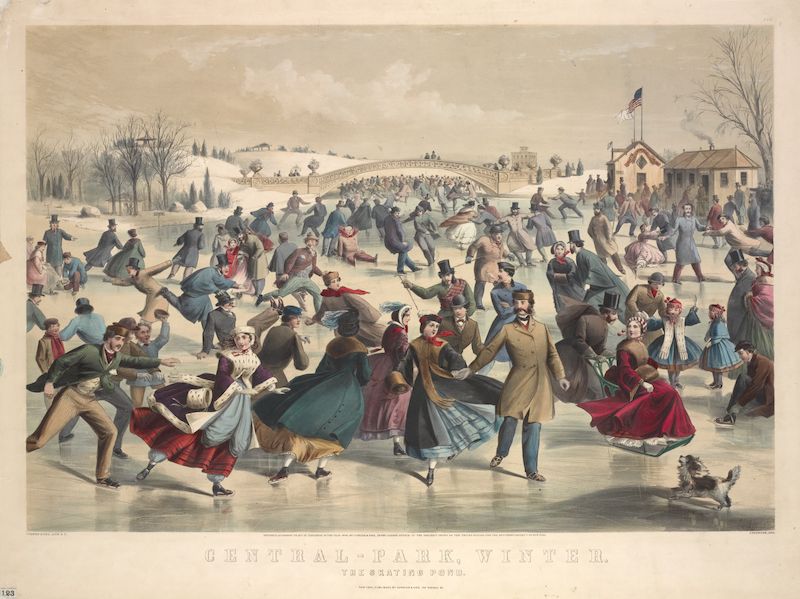
According to Untapped New York Insider and ice skating connoisseur Robyn Roth-Moise, “Ice skating, like many sports, goes in and out of style. The first part of Central Park that opened to the public was ice skating on the lake. Ice skating had become very popular in the 1850s-1860s. Back then, they lowered the water level so it would freeze. The Ice Skating Club of New York was founded in 1863 and was the second club to be founded in the US.”
Mitchell’s Pond at 58th Street and Fifth Avenue, which was also quite popular at the time, became part of the New York Skating Club that year. Although the club was members-only, ice skating across the city was accessible to all people from all backgrounds and economic statuses. The Empire City Skating Rink at 63rd Street and Third Avenue had more than 3,000 people on its first day in 1868.
Ice skating was not just limited to Manhattan; popular sites in Brooklyn included McCarren Park, Prospect Park, Sunset Park, and Commodore Barry Park. There was a tradition of “raising the red ball” on Brooklyn streetcars as a way of indicating skating conditions at Prospect Park. Union Pond in Williamsburg was another notable spot, opening in 1861. Union Pond, which was cleaned by several horses, featured live music and advanced lighting systems, as well as nearby pagodas. Staten Island may have had its own rink at Willowbrook Park as well.
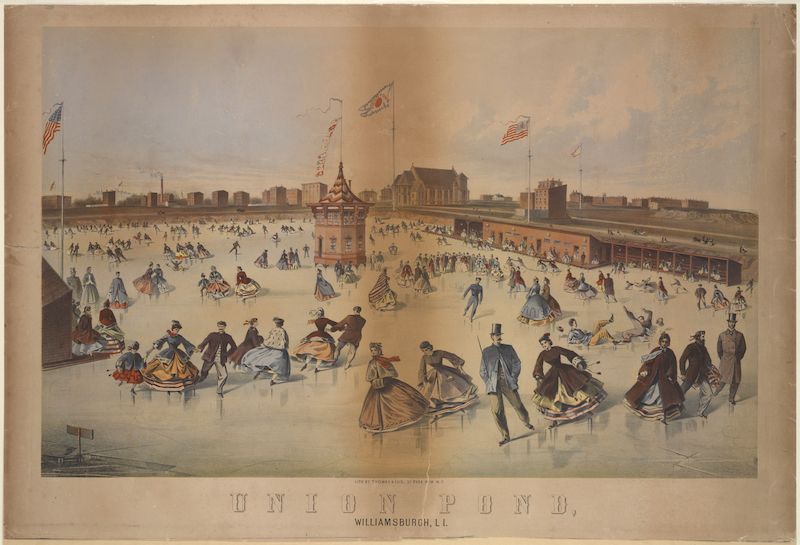
Frances Rosenfeld, a curator at the Museum of the City of New York, organized the museum’s exhibition New York on Ice: Skating in the City, which estimated that there were about 116 rinks in New York — at least, that’s how many Rosenfeld came across. This included indoor rinks, which became feasible in the 1890s, as well as many luxury “ice gardens” and rinks on rooftops and inside theaters and nightclubs. As a result of technological developments, hockey became a popular sport in New York, leading to the creation of some informal teams around the turn of the century.
In the early 1900s, many venues hosted ice shows, which were further popularized by the arrival of Charlotte OelSchlägel to New York from Berlin. OelSchlägel, an ice skating celebrity who performed in shows since she was 10, made frequent appearances at the Hippodrome Theater on 43rd Street and Sixth Avenue, combining music with dance over 400 times in 300 days.
The first facility formally devoted to ice skating was the New York City Building at Flushing Meadows-Corona Park, which was constructed for the 1939-40 World’s Fair. The rink hosted ice shows during the World’s Fair, but it was later converted to an ice and roller skating rink that closed in 1946. The New York City building was temporarily used as a site for the U.N. General Assembly, and after the U.N. found its permanent home, the building returned to being an ice and roller skating rink in 1952. “Ice–Travaganza” performances at the rink, organized by Dick Button, were popular at the 1964-65 World’s Fair.
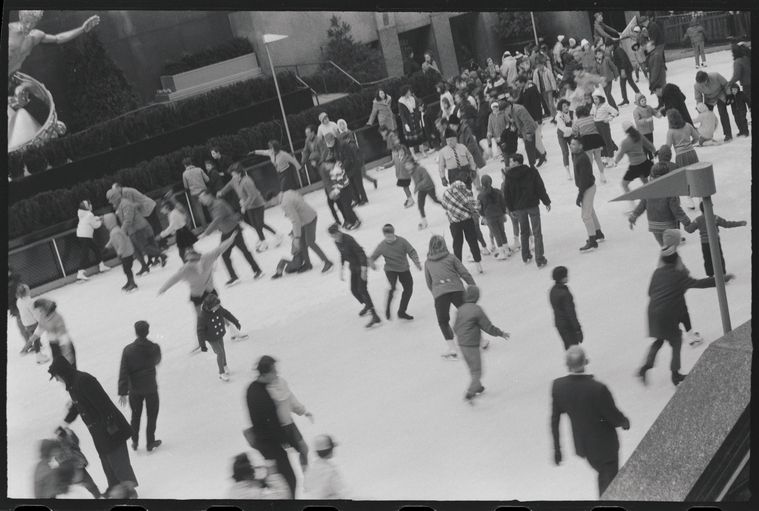
Around the time the Queens rink opened, the Parks Department converted flooded baseball fields and tennis courts into temporary ice rinks. On Christmas Day in 1936, the Rink at Rockefeller Center opened, and just a few years later, the Center Theater debuted an “Icetraveganza” called “It Happens on Ice,” which attracted over nine million people over the course of a decade.
“I loved ice skating at Rockefeller Center,” Roth-Moise told Untapped New York. “As a child, I skated with many famous people, I got to skate in a few of the tree lightings, and had my photo taken on the first day of the skating season at the rink for the local papers. I remember Rockefeller Center used to have a huge Halloween party. My parents took me to a costume rental store, and my photo, as well as my parents’, appeared in the papers. We as a family always had a couple of lockers at the rink, and then as an adult, I always had a season pass.”
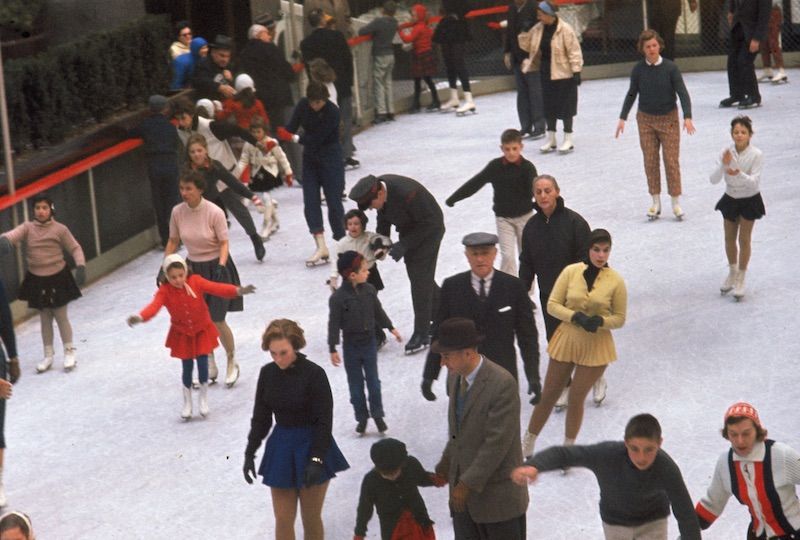
The Manhattan photographer, who has skated at Rockefeller Center every year since 1959, continued, “As a child, I ice skated at Rockefeller Center and Iceland, which was where the NYSC was housed. Iceland was adjacent to MSG on West 50th street. I can still remember all the ice shows I would see at MSG. Many of the rinks that were around in the city were gone by the 1960s. If you were a competitive skater after MSG was torn down, you skated at Skyrink, which was located in an office building located at 450 West 33rd Street on the 16th floor. When that rink was going to close, Chelsea Piers was created and the skating club moved there where it still is today.”
In 1949, philanthropist Kate Wollman funded an “artificial rink” to be built in Central Park. Wollman gave $600,000 toward the construction of Wollman Rink to honor her parents and brothers. About a century after the development of the Lake, Wollman Rink opened in 1950, with plenty of opportunities for safe skating regardless of the weather. Over 300,000 skaters glided across the ice in its first year of operation. Wollman also funded Central Park’s Lasker Rink in the north and Prospect Park’s rink.
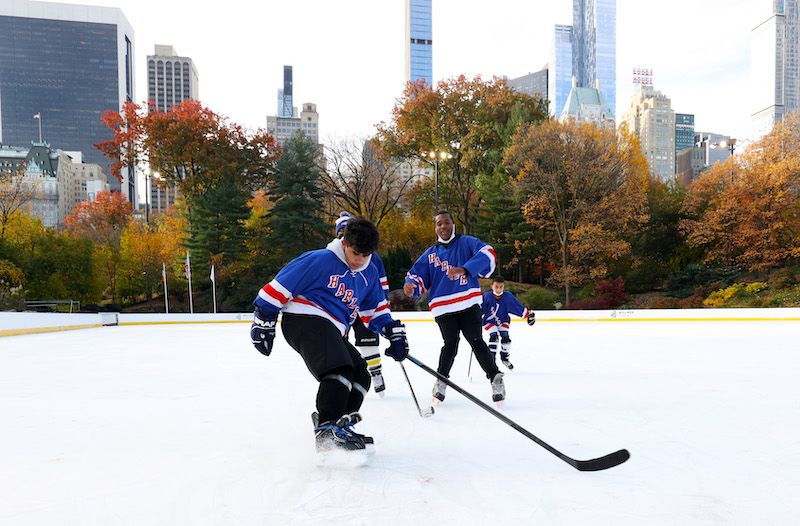
“Figure Skating in Harlem used to have a gala at Wollman Rink that was called skating with the stars,” said Roth-Moise. “You were literally skating with a list of who’s who in skating, that was always a fun event. Nothing like skating with Dorothy Hamil or Scott Hamilton to name a few. The Today Show when ice skating was very hot would have a host of Olympic skaters perform, and I was fortunate enough to be down on the ice or next to the ice to watch them skate. I got to hold Meryl Davis’s Olympic gold medal as well Adam Rippon’s bronze medal as well as photograph all of the skaters over the years.”
Both of Roth-Moise’s daughters learned to skate at a 40×60 rink located on the second floor on 74th Street and Lexington Avenue called the Ice Studio. She also reflected how the World Trade Center had a rink for a few years that closed due to safety conditions. Some of her favorites at Brookfield Place and South Street Seaport recently opened.
Reflecting on her time at the rink at Rockefeller Center, Roth-Moise said, “Growing up at the rink, everyone knew me. My parents were able to leave me there for hours and not worry. Back then you could walk through the restaurant in your skate guards to the coffee shop — no more. It was until recently a place where everyone knew you, we were the regulars. Through my adult years of ice skating at the rink, I was able to befriend many, many well-known figure skaters. I would photograph Olympic Pair skater JoJo Starbuck’s early morning workout class she would offer two mornings a week at 7:30 am. She would bring guest coaches whose names and faces you would know. The ice skating world is a small close-knit family and I am proud to have many as friends.”
NYC Parks has put together a collection of vintage photos on The History of Ice Skating in New York City. Next, check out some of these vintage photos and a bit more history of ice skating in New York.
Subscribe to our newsletter